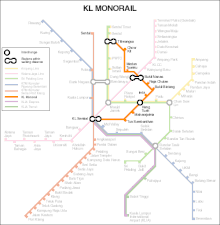KL Monorail
Template:Infobox Public Transit Kuala Lumpur
The Kuala Lumpur monorail system in Malaysia opened 31 August 2003, and serves 11 stations running 8.6 km with two parallel elevated tracks. It connects Kuala Lumpur's main station KL Sentral with the "Golden Triangle". It was built for RM1.18 billion by KL Infrastructure Group Berhad (KL Infra) that holds a 40-year concession to operate the monorail. The system utilises permanently coupled 2-car trains, which are able to accommodate 158 passengers each during regular operations. The monorail carriages themselves were built by a Malaysian company.[1]
Stations
The stations from north to south are:[2]
| Station name | Interchange |
|---|---|
| Titiwangsa | C Ampang Line and D Sri Petaling Line |
| Chow Kit | |
| Medan Tuanku | |
| Bukit Nanas | Walking distance to E Kelana Jaya Line |
| Raja Chulan | |
| Bukit Bintang | |
| Imbi | |
| Hang Tuah | C Ampang Line and D Sri Petaling Line |
| Maharajalela | |
| Tun Sambanthan | |
| KL Sentral | Walking distance to A Sentul-Port Klang Line, B Rawang-Seremban Line, E Kelana Jaya Line, KLIA Ekspres, KLIA Transit and KTM intercity trains |

Fares
Depending on distance, a one-way trip costs between RM1.20 and RM2.50. Commuters can use a Touch 'n Go card at monorail stations; these cards may be used throughout the Kuala Lumpur transit system.
Ridership

The monthly ridership has increased from 341,850 passengers in September 2003 to 1.18 million passengers in August 2004. As of 2005, ridership is currently averaging 45,000 passengers per day. The monorail has carried 25 million passengers since its opening.
Financial performance
For the financial year ending 30 April 2004, KL Infra posted a net loss of RM46.24 million on a RM15.08 million revenue. [1]
Expansion

- Linkage to Mid Valley Megamall is planned.[3]
There is ample room for train expansion. Currently, trains have only two carriages each and are overcrowded at peak times, and they are also much shorter than the station platforms.
Accidents
David Cheliah
Prior to the opening of the KL Monorail an accident occurred involving a safety wheel from a train falling off and hitting a pedestrian walking under the monorail viaduct. The victim, Mr. David Cheliah, a journalist by profession, suffered injuries that required hospitalisation. The matter was settled out of court under undisclosed terms.
The monorail company reported that any such accident was "unlikely" as 6 bolts would have to be removed for it to occur. Furthermore a check of all 23 other safety wheels on the train involved did not turn up any other issues.
As a result of this accident, the launch of the monorail was postponed.
Criticism
Integration with other lines
The Klang Valley public rail transit system are not seamlessly integrated for ticketing or changing trains. The monorail, the newest component of the system, has been publicly criticised over the way its stations have been connected to the other systems. The KL Sentral monorail station is 140 metres away from the main KL Sentral building, separated by a giant car park and a busy road. Pathways were not covered until <--a date ofr duration would be best here--> until well after construction.
Recently, stalls for petty traders have been put up along the covered pathway causing the pathway to be crowded, poorly ventilated and difficult to navigate due to poor signage[citation needed].
Common ticketing
As a critical component of the Klang Valley public transportation system, the KL Monorail does not accept Rapid KL passes.
It however accepts Touch 'n Go cards. It was only made available as recently as August 2005.
Poor ergonomics
Not many escalators have been provided. Platforms are narrow and ventilation is poor. Users have to walk up and down many stairs to reach the platform. "Overhead bridges" allow passengers to cross from one platform to another, confirming the monorail's reputation of it being merely a joy-ride.
The monorail ride is bumpy and there have been safety concerns, especially after the David Cheliah incident.
The seating configuration, where seats are arranged in the middle of the carriage, have been criticised as it encourages standing passengers to stand by the doors and not move into the middle of the carriages, causing the train to appear more full than it actually is.
Expensive rides
Ticket prices have also been criticised. Compared to other similar journeys of similar distances on other modes of rail transport in the Klang Valley, monorail ticket prices are the highest. For example, a one station ride from Bukit Bintang to Imbi (a walking distance) is RM1.20, while a longer one station ride from Masjid Jamek to Pasar Seni on the Kelana Jaya Line costs RM1.00.
Poor planning in construction of viaducts
Columns supporting the rails have been poorly placed at a few locations. Most notably is at Jalan Sultan Ismail of which the parts between Bukit Bintang and Jalan P Ramlee are one way. The columns have been constructed in the middle of the road, before it was turned one way, so much so that in spite of Jalan Sultan Ismail being one way, it remains a dual carriageway. This has been potentially confusing for road users.
References
- ^ "Kuala Lumpur" (html). Retrieved 2007-02-15.
- ^ "Kuala Lumpur Monorail Special Page 1". Retrieved 2007-02-15.
- ^ "Monorail News Briefs archives 09/26/04-01/04/05" (html). Retrieved 2007-02-15.
See also

External link
- KL Monorail official site.
